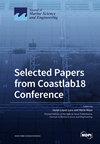Numerical Simulation and Experimental Study of the Pneumo-Electric Hybrid-Driven Pipeline Inspection Robot in Low-Pressure Gas Pipeline
IF 2.7
3区 地球科学
Q1 ENGINEERING, MARINE
引用次数: 0
Abstract
Intelligent pipeline inspection is necessary to operate submarine pipelines safely. At present, speed excursion and blockage are the challenges in the inspection of low-pressure gas pipelines. Accordingly, this study proposes a novel pneumo-electric hybrid-driven scheme to improve the traveling stability of inspection robots. To adapt to different working conditions, building blocks and CFD numerical simulation methods are used to study the throttling pressure control flow field of the robot. The results proved that the flow clearance had the most evident effect. The flow clearance was reduced from 30 to 5 mm, and the differential pressure of the prototype increased from 0.3 to 17 kPa. The skeleton diameter has a small effect on the differential pressure. The differential pressure increases as the gas velocity increases. By analyzing the prototype in different positions, it was found that the differential pressure of the prototype while passing the elbow decreased by 45% at 45°, which quantified the fluid-driven force gap of the prototype while passing through the elbow. Finally, by comparing the speed of prototype with that of fluid-driven pig, it is demonstrated that a pneumo-electric hybrid-driven scheme is an effective solution to the problem of unstable inspection operation of low-pressure gas pipelines.低压天然气管道气电混合驱动管道检测机器人的数值模拟与实验研究
智能管道检测是安全运行海底管道的必要条件。目前,速度偏移和堵塞是低压天然气管道检测中的难题。因此,本研究提出了一种新型气电混合驱动方案,以提高检测机器人的行进稳定性。为了适应不同的工作条件,采用积木和 CFD 数值模拟方法研究了机器人的节流压力控制流场。结果证明,流动间隙的影响最为明显。流动间隙从 30 mm 减小到 5 mm,原型的压差从 0.3 kPa 增加到 17 kPa。骨架直径对压差的影响较小。压差随着气体速度的增加而增加。通过对不同位置的原型进行分析,发现原型在通过弯头时的压差在 45° 时下降了 45%,这量化了原型在通过弯头时的流体驱动力间隙。最后,通过比较原型与流体驱动猪的速度,证明气电混合驱动方案是解决低压燃气管道检测操作不稳定问题的有效方案。
本文章由计算机程序翻译,如有差异,请以英文原文为准。
求助全文
约1分钟内获得全文
求助全文
来源期刊

Journal of Marine Science and Engineering
Engineering-Ocean Engineering
CiteScore
4.40
自引率
20.70%
发文量
1640
审稿时长
18.09 days
期刊介绍:
Journal of Marine Science and Engineering (JMSE; ISSN 2077-1312) is an international, peer-reviewed open access journal which provides an advanced forum for studies related to marine science and engineering. It publishes reviews, research papers and communications. Our aim is to encourage scientists to publish their experimental and theoretical results in as much detail as possible. There is no restriction on the length of the papers. The full experimental details must be provided so that the results can be reproduced. Electronic files and software regarding the full details of the calculation or experimental procedure, if unable to be published in a normal way, can be deposited as supplementary electronic material.
 求助内容:
求助内容: 应助结果提醒方式:
应助结果提醒方式:


